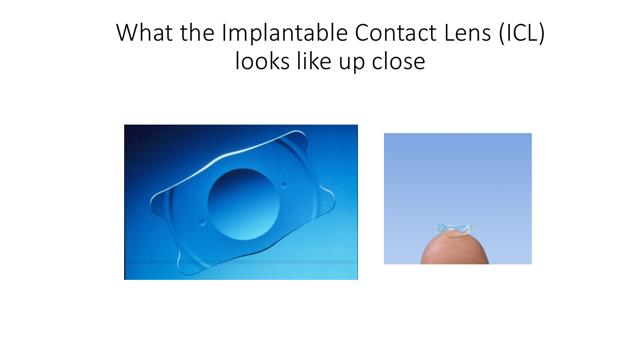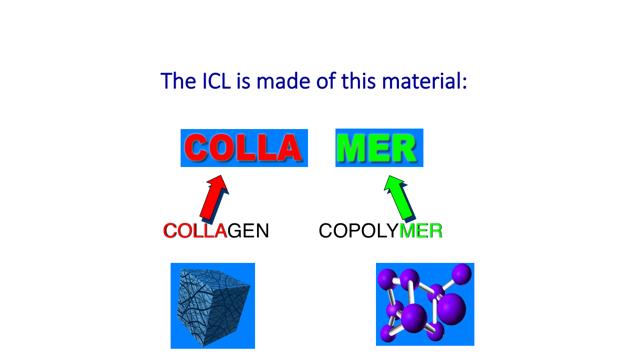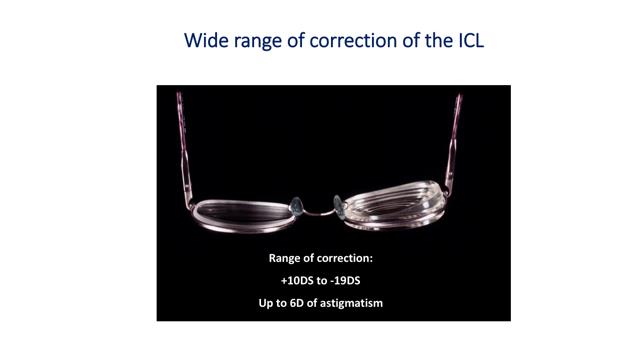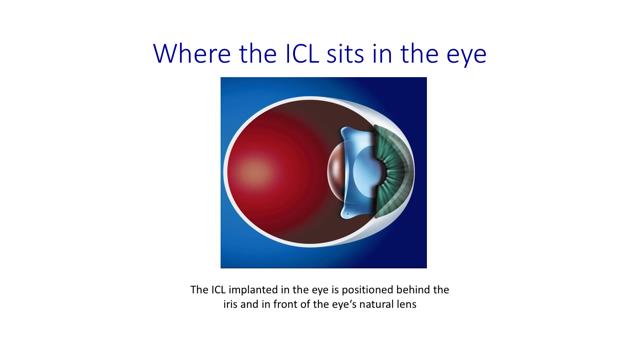Implantable Contact Lens (ICL) in Singapore
The Visian Implantable Contact Lens (ICL)
Implantable Contact Lens (ICL) may be a viable option for patients not suitable for LASIK, ReLEx SMILE, or other laser vision correction procedures. While LASIK remains the most popular refractive surgery globally, factors like extremely high refractive errors or thin corneas can preclude some patients from these laser-based solutions. In such cases, ICL offers a safe and effective alternative.
The goal of ICL surgery is to improve one’s vision and to reduce dependence on spectacles or contact lenses. Most individuals may be able to be fully independent of glasses or contact lenses, but some may still require glasses, especially if they have presbyopia, the need for reading glasses as one ages.
What Can the ICL Correct?
The ICL can correct the following refractive errors:
- Short-sightedness (myopia)
- Far-sightedness (hyperopia)
- Astigmatism

What is the ICL all about?
ICL surgery refers to the implantation of a lens (the ICL) in the eye behind the iris and in front of the eye’s natural lens to correct a wide range of refractive error
The ICL is a lens made of a very soft, foldable material (Collamer) that is highly biocompatible with our eye. This material also contains a UV filter which protects the eye against the negative effects of the sun.
The procedure is not entirely new, as the first of such an implant was inserted in 1991 in a patient in Russia. The ICL received approval from the US Food and Drug Administration (FDA) in 2006.

How does the ICL Work?
The ICL works very similarly to a contact lens. The difference is that it is not placed on the surface of the eye, but instead, sits inside the eye. As such, the patient will not be able to feel the presence of the lens in the eye once it is inserted. It is also invisible to the observer’s eye. Your friends will not be able to see the ICL in your eye!
The ICL is designed to remain inside the eye and need not be removed. It does not require maintenance like contact lenses which need to be removed, changed or cleaned regularly.

What are the Advantages of the ICL?
ICL is a safe and effective refractive surgical option. Here are its main advantages:
- It can correct a very wide range of refractive error, independent of cornea thickness. The range of correction is +10DS to -19DS (1000 degrees of far-sightedness and 1900 degrees of short-sightedness), and 6D (600 degrees) of astigmatism.
- It provides excellent, high quality vision
- The visual outcomes are highly predictable and stable
- Glare and haloes and night vision problems are usually less than in laser vision correction procedures on the cornea.
- The procedure is reversible (the ICL can be removed, but through additional surgery).
What are the Potential Side Effects of ICL Surgery
As ICL surgery involves surgery inside the eye (intraocular surgery), the potential risks are slightly higher than in laser vision correction on the cornea (the outer front covering of the eye). The surgery is still very safe, and serious complications are rare.
Some of the possible side effects include a rise in eye pressure, inflammation, clouding of the crystalline lens, cornea swelling, over -and- under-correction. Fortunately, serious side effects like infection and retinal detachment are rare.

What to Expect During ICL Surgery?
This is what to expect:
- ICL surgery is an outpatient procedure.
- It is performed either under topical, local or general anesthesia. Your surgeon will make this choice together with you.
- The ICL is injected through a small wound into space in front of the natural lens of the eye.
- The wound through which it is injected is self-sealing and no stitches (sutures) are required.
In some cases, a few days or weeks prior to the actual ICL surgery, a laser is used to create one or two small holes in the iris (the colored part of the eye). This is to allow proper drainage of fluid in the eye, preventing the eye pressure from increasing after ICL implantation. This procedure, called a laser peripheral iridotomy, is not required in most cases
What to Expect After ICL Surgery
Here are important points to note:
- Visual recovery after the ICL is rapid, but is not instantaneous.
- You will find that your eye sight is still foggy immediately after the surgery. The vision usually improves gradually over the next few hours. By the next day, you will be able to see well, but you will be encouraged to rest for a few days before resuming your usual daily activities.
- You will be prescribed antibiotic and steroid eyedrops as well as artificial tears to keep the eyes moist. Overall, the surgery and post-surgery recovery, like LASIK, is a pleasant experience for most patients.
Most patients are able to return to work a week later.
Is LASIK, SMILE or the ICL better for me?
All three procedures give excellent visual outcomes. Each procedure has its inherent advantages.
Dr Cordelia Chan has had many years of experience performing LASIK, SMILE and the ICL, and based on your profile and needs, she will be able to best advise you on which procedure is best.
